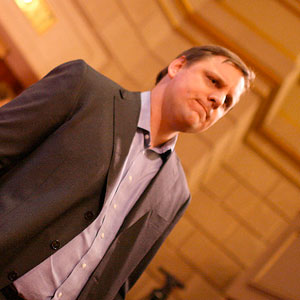This month, the big news online is online news. On Feb. 2, Rupert Murdoch launched The Daily, the world’s first iPad “newspaper,” at a cost of $30 million. Stealing his thunder a couple days later, AOL announced its purchase of the Huffington Post for $315 million. And then, last week, Gawker Media relaunched its fleet of edgy blog sites with a radical redesign that fundamentally rejected the traditional blog format.
The latter event is significant because Gawker has been at the forefront of the online publishing game for what we now consider a long time. And while the Huffington Post generates a lot of hype, Gawker in fact generates more page views: According to Quantcast, 30 million people visit Gawker sites each month while 25 million go to Huffington Post.
Gawker’s Nick Denton, a British-born, Oxford-schooled 10-year veteran of The Financial Times, was an original new media innovator. His career, which had taken him from London to Budapest and New York, eventually landed him in Silicon Valley as the turn of the millennium approached. He remained for only a couple of years before he decided to head back East, but it was here that he seems to have hit upon Gawker’s two primary innovations.
One was likely inspired by Denton’s last piece for FT—a story about a couple of Harvard dropouts who had come to California and made a mint on a company called LinkExchange. Soon after arriving in New York and setting up shop in his SoHo loft, Denton began to launch blogs at a furious pace—and link them all together.
Over the next few years, in addition to Gawker itself, he gave birth to dozens of websites, each focused on a specific topic: Gizmodo (tech toys), Fleshbot (alt-porn), Defamer (celebrity gossip), Wonkette (DC gossip), Lifehacker (practical tricks), Kotaku (video games), Deadspin (sports), io9 (sci fi), Jalopnik (cars) Jezebel (woman-centric sex and fashion) and our personal favorite, Valleywag (Silicon Valley news and gossip).
Many of the Gawker sites rapidly gained traction—partly because of the cross-linking strategy Denton had learned from the LinkExchange guys. But the primary reason for their popularity was their voice. Every one of Gawker’s universally talented writers had a gift for the blog world’s signature characteristic: snark.
New York magazine’s Vanessa Grigoriadis described the phenomenon in a 2007 profile: “They didn’t exactly invent the blog, but the tone they used for Gawker became the most important stylistic influence on the emerging field of blogging and has turned into the
de facto voice of blogs today.”
Another Gawker traffic driver was not a Denton innovation but something that was already present in the blogosphere’s publish-now, check-later ethos. Gawker became a scoop machine. As the sites matured, Gawker broke a number of stories that put it on the media map: a Scientology pitch video starring Tom Cruise; a brilliantly nasty exposé of the sexual habits of Tea Party candidate Christine O’Donnell; Brett Favre’s unwanted advances toward a comely sideline reporter; a security breach that exposed the email addresses of 100,000-plus iPad owners.
And last week, two days after Gawker’s relaunch, as if by plan, came its biggest-ever scoop. There on the newly redesigned homepage was a photo of Republican Rep. Christopher Lee, shirtless and buff, and the story of the “Craigslist Congressman” who evidently used the classifieds site to find extramarital love. When the congressman resigned the following day, an independent blog headline asked: “Did Chris Lee’s Resignation Have Anything to Do With the Gawker Redesign?”
Valleywag vs. Tech Crunch
The Gawker team’s one-two punch of snark and scoops has not been universally beloved. In Silicon Valley, another pioneering blogger, Michael Arrington, has often taken professional and personal offense at Valleywag’s stunts. He has aired these on TechCrunch, an influential site he launched in 2005.
The battle seems to have been engaged soon after Valleywag was launched in 2006. Its first editor, Nick Douglas, apparently sent a flurry of emails to Arrington’s business associates digging for dirt. Several of the missives were forwarded to Arrington, and he followed up with a post headlined “Valleywag Is Getting Lame.” The fight escalated for years, with Valleywag publishing frequent items mocking its larger competitor, and TechCrunch responding with occasional withering critiques.
{pagebreak}
 In 2008, Arrington (left) penned a piece attacking a Valleywag post about an alleged sexual encounter between “a notable technology visionary” and “a woman who appears to be looking for as much publicity as possible.” The piece concluded that the irreverent gossip site’s coverage was nothing short of immoral.
In 2008, Arrington (left) penned a piece attacking a Valleywag post about an alleged sexual encounter between “a notable technology visionary” and “a woman who appears to be looking for as much publicity as possible.” The piece concluded that the irreverent gossip site’s coverage was nothing short of immoral.
Arrington wrote: “How long will it be before Valleywag drives someone in our community to suicide? My fear is that it isn’t a matter of if it will happen, but when. Valleywag and Nick Denton, though, will likely look forward to the event, and the great traffic growth that will surely follow.”
In November of last year, Arrington sold TechCrunch to AOL for a reported $30 million. Although he announced the deal at the annual Disrupt convention, which TechCrunch co-sponsors, that story broke on Valleywag.
At the time of the sale, Arrington, who appears to be more committed to covering Silicon Valley tech culture than any reporter on the planet, swore that he would retain editorial independence despite his new corporate overlords. But he admitted that the site would have to expand its scope beyond the valley.
Where’s Valleywag?
In the week since the Gawker redesign, I have been unable to find Valleywag. Although the site was officially merged with Gawker in late 2009, the URL valleywag.gawker.com displayed a homepage with a Valleywag header and posts by the section’s editors, Ryan Tate and Adrian Chen. Beginning last week, that URL redirected users to the Gawker homepage. The Valleywag logo was gone.
I sent emails to Tate and Chen but got no responses, so today I emailed Nick Denton himself. He replied that there was “no real change to Valleywag status. It’s a section of Gawker, as it has been since 2009.” In a follow-up note, he conceded that “we did tone down the branding.”
With Gawker consolidating and TechCrunch now part of the AOL empire, and as the online media landscape explodes and convulses, the local media landscape may be loosing two of its most powerful independent voices.

 Trio Nobilis
Trio Nobilis 
